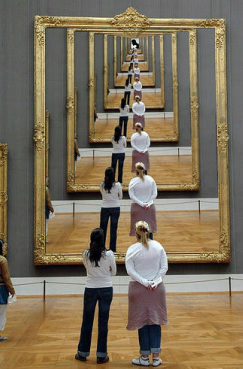We must first understand that for Eliade, religion was an independent category and the irreducibility of "the sacred" that was its "essence." Following Otto, Eliade sees religion as an aspect of consciousness and the sacred an ahistorical component of world. For something to be sacred, it must manifest itself as a hierophany. This is the function of myth. First, myth narrates sacred history; it explains origins of current world traced back to primordial beginnings (Eliade 1963, 181). Second, myth serves as a model for human action, and third, humans reenacting exemplary acts of the gods, "magically reenter the Great Time, the sacred time." According to Eliade, this encounter with the divine rejuvenates humans.
Among the many manifestations of hierophant, Eliade was most concerned about the "dialectic of hierophanies." This is where the sacred expresses itself in something other than itself (26). It is an earlier version of his concept of camouflaged myths, ancient stories retold in contemporary plays, movies, and books. (Segal 2001) Modern versions include Superman or the eschatology of Marxists who reproduce the motif of the original golden age, the fall, the battle between good and evil, triumph of good, and restoration of the golden age. Eliade argues that an eternal mythic power must be religious, unlike Jung and Campbell who allow for secular myths.
Eliade's work has been dismissed --even eviscerated -- by many scholars, but I am intrigued by his notion of camouflage of the sacred. As a prolific novelist of magical realist tales drawn from the myths he gathered, he offers us the "unrecognizability of the miracle," how mythological interventions in profane reality are not seen. (Calinescu, 1982 157) Okuyama Michiaki tracks Eliade's preoccupation with the “camouflage of miracle in history" in Oe Kenzaburo's novels and uncovers along the way an "Autobiographical Fragment" of Eliade. It is here Eliade addresses the problem of the "unrecognizability of the miracle" and how to find the hidden miracle among "manifestations which do not apparently differ in any way from millions of cosmic or historical manifestations (a sacred stone is not different, apparently, from any other stone, etc.)." (cf Michiaki 123-124)
All those stones, so little time. How do we find the sacred one? Gregory Bateson tells us not to try. Don't divulge the secret, he warns us. He argues about this with his daughter Catherine Bateson in Angels Fear. Epistemology of the Sacred.
Bateson argues that the sacred is usually protected through secrecy and not communicating is important so as to contain this powerful knowledge. He reminds us that the ancients (mostly Greek) considered discovery, invention or knowledge dangerous (Prometheus' punishment for stealing fire, or Adam and Eve for eating the apple).
Here is a Balinese tale he tells in which the folk figure must conceal knowledge and the fact that he is concealing.
Adji Darma (literally “Father Patient” or “Father Long Suffering”) was walking in the forest one day and there he found two snakes copulating. The male snake was just an ordinary viper but the female was a cobra princess: they were breaking caste rules. So Adji Darma got a stick and beat them. They slithered off into the bushes. The cobra girl went straight to her daddy, the king of all the cobras, and told him: “That old man, he’s no good. He tried to rape me in the forest.”
The snake king said, “Oh, did he?” and called for Adji Darma. When the old man came before him, the king said, “What did happen in the bushes?” and Adji told him.
The king said, “Yes. Just what I thought. You did right to beat them an you shall be rewarded. Henceforth you shall understand the language of the animals. But there is one condition: If you ever tell anybody that you know the language of the animals, this gift will be taken from you.”
So Adji went home and in bed that night, as he lay beside his wife, he listened to the gecko lizards up in the thatch. The geckos say “heh! heh!” with a sound like the laughter of people who laugh at dirty stories. Indeed it was dirty stories that they laughed at, and Adji Darma with his new knowledge was able to hear and understand the stories. He laughed too.
His wife said, “Adji, what are you laughing at?”
“Oh ... oh ... nothing, dear.”
“But you were laughing. You were laughing at something.”
“No. It was just a thought I had, dear, it wasn’t important.”
“Adji, you were laughing at me. You don’t love me anymore.” And so on.
But still he did not tell her what he was laughing at, because he was not willing to lose the language of the animals.
His wife worried at this more and more and finally became sick, went into a decline, and died.
Then the old man began to feel terribly guilty and remorseful. He [[p_079]] had killed his wife just because he selfishly wanted to go on knowing the language of the animals.
So he decided to have a suttee which would be the reverse of the ordinary. In an ordinary suttee, the widow jumps into the pyre on which her husband’s body is being burned. He would jump into the flames of his wife’s cremation. A great pyre of wood was therefore built and decorated, as was the custom, with flowers and colored leaves; and beside it he had the people build a platform with a ladder up to it so that from this platform he could jump into the flames.
Before the cremation, he went up onto the platform to see that it was as it should be and how it would be to jump. While he was there, two goats came by in the grass below, a billy goat and a pregnant nanny, and they were talking.
Nanny said, “Billy, get me some of those leaves. Those pretty leaves. I must have some to eat.”
But Billy said, “Baaaaaaaa.”
Nanny said, “Billy, please. You don’t love me, Billy. If you loved me, you would get them. You don’t love me anymore.” And so on.
But Billy only said, “Baaa. Baaa.”
Adji Darma listened to this and suddenly he had an idea. He said to himself, “Ha! That’s what I ought to have said to her,” and he practiced saying it two or three times, “Baaa! Baaa!” Then he got down off the platform and went home.
He lived happily ever after.
But what does it have to do with secrets? His daughter, Catherine Bateson is less concerned with the inconsistencies of this story, than how secrecy protects the powerful. She wonders if instead if "certain kinds of secrecy do in fact function as markers for the sacred" and that sacred secrets are designed to be revealed. For example, she offers, initiates are whipped by masked dancers who then unmask and reveal they are just dancers, not gods. At some point, in the ritual process the initiates mask themselves.
DAUGHTER: And you couldn’t have a god in the system, since omniscience would destroy flexibility. You need a different word... unknowing or mystery, preferably a word that would highlight the fact that a lack of self-consciousness is right in the center of this business of noncommunication...The fact of unknowing as a factor for unity and flexibility in systems. When it is important that systems sustain internal boundaries by a sort of profound reflexive ignorance.
FATHER: I have been talking about the sacred as related to a knowledge of the whole – but the other side of that coin may be a certain necessary gradient of knowledge. The next step will be to look for analogous kinds of noncommunication that are not artifacts of human cultural systems.
DAUGHTER: Daddy, there’s something else in the Adji Darma story. The question “Do you love me?” doesn’t work, does it, any more than Joe Adam’s instructing you to record spontaneity or photographing prayer or prescribing sea snakes or even getting the violin right one note at a time? The all masquerade as reporting, but they change the context of the interaction.
So what do we have here? The importance of the secret, the unknown, in modulating information in a system premised on uneven distribution. In an era of such pervasive confession, 24/7 reportage, and surveillance, maybe the camouflage is a necessary aspect of modern life in which too much is knowable. Perhaps "unrecognizability" preserves the secret for only the initiated. Secrecy increases the value of sacred knowledge, but only when it is revealed. And in any case, "camouflaged miracles" are only considered miracles to those who consider them such, who participate in what Hervieu-Leger calls a "chain of memory."
One person's miracle is another's unreal. Who is more literal, the believer or the skeptic? And might the literalness of skeptics suffer from a deficit of the unreal? Eliade borrowed Bachelard's notion of the "function of the unreal," as a way to reflect on his literary bent on magical realism. The unreal has a necessary function, Bachelard, writes, "A person deprived of the function of the unreal is just as neurotic as the one deprived of the reality function. It could even be said that difficulties with the function of the unreal have repercussions for the reality function. If the imagination's function of openness is insufficient, then perception itself is blunted." (7)
For Bachelard, play, make believe, daydreaming, fantasy are necessary elements in imaginative life, a soulful existence. Bateson asks, "what sorts of ideas create distraction or confusion in the operation of that matrix so that creativity is destroyed?" Perhaps too much talk, the idea that everything must be shared destroys our sense of mystery. Perhaps we need the imaginative (imaginary) as a necessary mechanism to cultivate the secrets not to tell, the places that evade map quest, and languages we know but do not share. Perhaps in the age at the end of privacy, the camoflague of the sacred, its unrecognizability is the only way to preserve it before we find it again.
FOOTNOTES
1. In History of Religious Ideas, Vol. 1, Eliade announced that he would deal with the camouflage of the sacred.
2. Eliade, the demigod of History of Religions, has been legitimately "deconstructed" at the personal, political and philosophical spheres. One might feel a little sympathetic to his demise at the hands of the intellectual red guard's "cultural revolution." Took earlier demo-gods and put them in dunce-caps. That's the sentiment of Wasserstrom's Religion After Religion: Gershom Scholem, Mircea Eliade, and Henry Corbin at Eranos. Only Gershom Scholem escapes the cap. These theorists did contribute to the "myth and symbol" era of religion and anthropology; their work verged on esotericism and a mystical emphasis on transcendence. Though Jungians love Corbin's realm of the "imaginal," he is dismissed by academics, and Wasserstrom condemns him as a fascist.3. Martin Savransky, 'Worlds in The Making: Social Sciences and the Ontopolitics of Knowledge', Postcolonial Studies, 2012, 15, 3, 351-368
Cited
Calinescu, Matei, The function of the unreal: reflections on Mircea Eliade's short fiction, In Imagination and Meaning: The Scholarly and Literary Worlds of Mircea Eliade, Eds, Girardot, N. J., Ricketts, Mac Linscott.Seabury Press, 1982,
Bachelard, Gaston, Air and Dreams: An Essay on the Imagination of Movement, trans Edith and C Frederick Farrell, The Dallas Institute Publications, 1988
Bateson, Gregory, and Catherine Bateson, Angels Fear. Epistemology of the Sacred. NJ: Hampton Press, 2004
Eliade, Mircea, Autobiography. Vol 1: 1907-1937. Journey East, Journey West, trans Mac Linscott Ricketts. SF: Harper and Row, 1981
______Myth and Reality, trans Willard R Trask, NY Harper and Row, 1963
______Myths, Dreams and Mysteries, trans Philip Mairet, NY Harper Torchbooks, 1967, 25-26
______Patterns in Comparative Religion, London: Sheed and Ward, 1958 xiii
Chin-Hong, Chung, Mircea Eliade's Dialectic of Sacred and Profane and Creative Hermeneutics, In The International Eliade, Ed Bryan Rennie, Albany, NY: State University of New York Press, 2007, 187-208
Kuehn, Sara, The Dragon in Medieval East Christian and Pre-Islamic Art, BRILL, 2011
Murphy, Tim, Eliade, Subjectivity, and Hermeneutics, In Changing Religious Worlds: The meaning and end of Mircea Eliade, Edited by Bryan Rennie, Albany, NY: State University of New York Press, 2001, 35-48
Savransky, Martin. Worlds in the making: social sciences and the ontopolitics of knowledge, Postcolonial Studies, (2013) 15:3, 351-368, DOI: 10.1080/13688790.2012.753572
Segal, Robert. Are There Modern Myths? In Changing Religious Worlds: The meaning and end of Mircea Eliade, Edited by Bryan Rennie, Albany, NY: State University of New York Press, 2001, 25-34
Strenski, Ivan, Four Theories of Myth in Twentieth-Century History: Cassirer, Eliade, Levi-Strauss, and Malinowski. Iowa City: U of Iowa, 1987
Michiaki, Okuyama, Camouflage and Epiphany: The Discovery of the Sacred in Mircea Eliade and Oe Kenzaburo, In The International Eliade, Ed Bryan Rennie, Albany, NY: State University of New York Press, 2007, 229-246



 RSS Feed
RSS Feed
